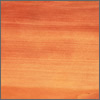|
|
||||
|
|
American sycamore (Platanus occidentalis)Other names: Buttonwood, American planetree
Click to enlarge DistributionThroughout Eastern USA. General descriptionThe sapwood of sycamore is white to light yellow, while the heartwood is light to dark brown. The wood has a fine close texture with interlocked grain. It is not related in any way to European sycamore but it has the same family classification, and similar characteristics to European plane. Contrasts well with other species. Working propertiesThe wood machines well, but high speed cutters are needed to prevent chipping. It is resistant to splitting due to the interlocked grain. The wood glues well and stains and polishes, with care, to an excellent finish. It dries fairly rapidly, with a tendency to warp. It has moderate shrinkage and little movement in performance.
Physical propertiesThe wood is classified as moderate in weight, hardness, stiffness and shock resistance. It turns well on the lathe and has good bending qualities. Specific Gravity: 0.49 (12% M.C.) DurabilityRated as non-resistant to heartwood decay. The sapwood is liable to attack by the common furniture beetle, but is permeable to preservative treatment. AvailabilityUSA: Reasonable availability in a range of specifications and grades
in lumber and veneer. Main usesFurniture, furniture parts (drawer sides), internal joinery, panelling and mouldings, flooring, kitchen ware, butchers blocks and veneered panels.
|
|
||||||||||||||||||||||||||||||||||||||||||||||||||||||||||||||||||||||||||||




